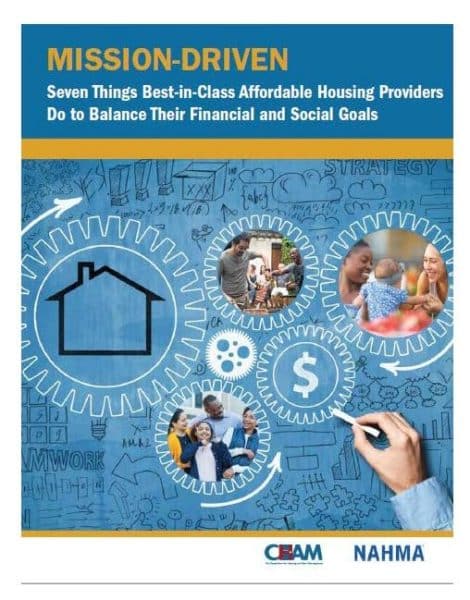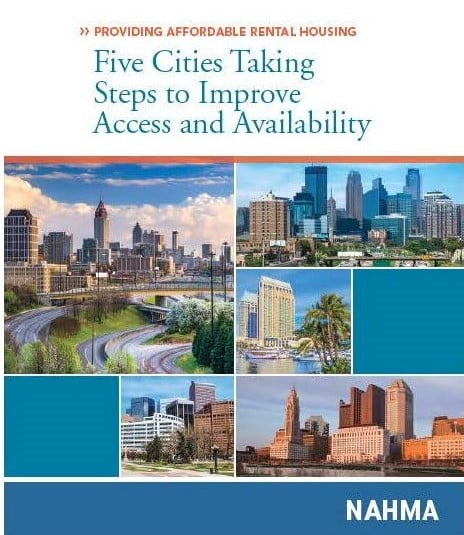NAHMA Supports Research on Key Affordable Housing Issues
The National Affordable Housing Management Association (NAHMA), as a leading voice for affordable housing management, advocating on behalf of multifamily property managers and owners whose mission is to provide quality affordable housing, is proud to sponsor research that further advances our mission of promoting the development and preservation of quality affordable multifamily housing by advancing legislative and regulatory policy and preparing affordable housing professionals to succeed in evolving economic and political environments.
The reports presented on this webpage are intended to provide information and insight and do not constitute advice or recommendations. Neither NAHMA nor the author nor others involved in the publishing of these reports shall be liable for any direct, incidental or consequential damages resulting from any action taken as a result of the information contained in the reports.
Mission-Driven: Seven Things Best-in-Class Affordable Housing Providers Do to Balance Their Financial and Social Goals
A report prepared for and commissioned by the Consortium for Housing and Asset Management and the National Affordable Housing Management Association. 
By Dustin C. Read, Ph.D., J.D.
Associate Professor of Property Management and Real Estate
William and Mary Alice Park Junior Faculty Fellow
Virginia Tech
Executive Summary
The Consortium for Housing and Asset Management (CHAM®) and the National Affordable Housing Management Association (NAHMA™) commissioned this study to investigate the steps best-in-class affordable housing providers take to remain mission-driven in the face of significant financial constraints. The recommendations that follow were derived from 38 interviews conducted with industry leaders.
-
Leverage Intra-Organizational Tension: Tensions frequently surface among affordable housing developers, asset managers, property managers and resident service coordinators. Ensuring those tensions are productive rather than destructive is what separates strong companies from weak ones. It can only be accomplished when senior leadership teams take steps to build trust, facilitate open discourse and provide those with divergent perspectives a seat at the table when mission-critical decisions are made.
-
Narrow the Scope to Broaden the Social Impact: The competitive environments affordable housing providers operate in require them to be recognized as experts in their field and have a brand identity that instills confidence among a variety of stakeholders from policymakers to community partners to private investors. As a result, many companies narrow the scope of their work to ensure they can advance their missions. This involves being selective about where they invest, the types of projects they take on and the sources of funding they rely upon.
-
Seek Out New Sources of Cash Flow: To bolster their financial position and expand their reach, a growing number of affordable housing providers explore ways to monetize their core competencies. Some provide fee management services and third-party resident service coordination, while others offer training programs, grant writing assistance and a host of other services to peer organizations. The trend is promising because it has the potential to encourage the dissemination of knowledge and the development of industry best practices.
-
Use the Mission to Attract and Retain Talent: The challenges of the affordable housing industry make it very difficult for companies to attract and retain talent. Thus, hiring individuals who are committed to the mission and putting resources in place to help them be successful is essential. Affordable housing providers accomplish this by recruiting in nontraditional places, implementing robust training programs and recognizing employee contributions.
-
Integrate Affordable Housing into the Fabric of Neighborhoods: Affordable housing providers now devote significant attention to the symbiotic relationships that exist between their properties and the built environments that surround them. Longstanding efforts to make affordable housing resilient to blighting influences are being supplanted by efforts to integrate affordable housing into the fabric of neighborhoods. Companies do this by making space available for community use, advocating on behalf of neighborhoods and adopting principles of community development.
-
Measure Resident Outcomes and Quantify the Impact on Financial Performance: How affordable housing providers measure success is changing. Developers, asset managers, property managers and resident service coordinators all feel increasing pressure to quantify the ways in which they improve the lives of the residents they serve and how those improvements affect financial performance. Companies who do this reap rewards, but only after having difficult conversations with internal and external constituencies about what is working and what is not.
-
Recognize Resource Scarcity, Demonstrate Intentionality and Emphasize Transparency: Industry leaders recognize that balancing the “mission” and the “margin” in the affordable housing space is an ongoing process and one that requires tradeoffs. Tough choices must be made in a transparent and intentional manner, while recognizing that financial solvency is a prerequisite to achieve any other goals an affordable housing provider may have Social objectives must therefore always be discussed within the context of the business case that supports them.
Five Cities Taking Steps to Improve Access and Availability
A report prepared for and funded by the National Affordable Housing Management Association. 
By Dustin C. Read, Ph.D., J.D.
Assistant Professor of Property Management and Real Estate
Virginia Tech
@ 2017 NAHMA
Foreword
In response to the nation’s severe shortage of affordable rental housing, the National Affordable Housing Management Association (NAHMA) has launched an initiative to identify and highlight Cities Where You Can Afford to Work and LiveTM. Across the country, teachers, firefighters, police, restaurant staff, retail workers and retirees among others—all core members of a healthy, vibrant community— can’t afford to live in the cities they have served. For many, more than half of their income goes to pay the rent, leaving little left over for food, utilities, transportation, health care, day care and other vital needs. This growing financial burden for basic rental housing for millions of Americans challenges the social and economic well-being of cities large and small. NAHMA’s goal is to identify and highlight innovative programs by cities that successfully increase the net number of affordable rental housing units in their communities. We are pleased to work with Dr. Dustin C. Read, Assistant Professor of Property Management and Real Estate at Virginia Tech, to publish the following overview of five cities that are finding success in implementing policies to address the shortage of affordable housing in their locales.


